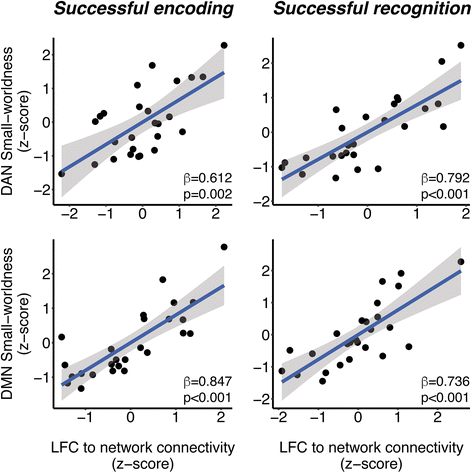The left frontal cortex supports reserve in aging by enhancing functional network efficiency
- PMID: 29510747
- PMCID: PMC5838935
- DOI: 10.1186/s13195-018-0358-y
The left frontal cortex supports reserve in aging by enhancing functional network efficiency
Abstract
Background: Recent evidence derived from functional magnetic resonance imaging (fMRI) studies suggests that functional hubs (i.e., highly connected brain regions) are important for mental health. We found recently that global connectivity of a hub in the left frontal cortex (LFC connectivity) is associated with relatively preserved memory abilities and higher levels of protective factors (education, IQ) in normal aging and Alzheimer's disease. These results suggest that LFC connectivity supports reserve capacity, alleviating memory decline. An open question, however, is why LFC connectivity is beneficial and supports memory function in the face of neurodegeneration. We hypothesized that higher LFC connectivity is associated with enhanced efficiency in connected major networks involved in episodic memory. We further hypothesized that higher LFC-related network efficiency predicts higher memory abilities.
Methods: We assessed fMRI during a face-name association learning task performed by 26 healthy, cognitively normal elderly participants. Using beta-series correlation analysis, we computed task-related LFC connectivity to key memory networks, including the default mode network (DMN) and dorsal attention network (DAN). Network efficiency within the DMN and DAN was estimated by the graph theoretical small-worldness statistic. We applied linear regression analyses to test the association between LFC connectivity with the DMN/DAN and small-worldness of these networks. Mediation analysis was applied to test LFC connectivity to the DMN and DAN as a mediator of the association between education and higher DMN and DAN small-worldness. Last, we tested network small-worldness as a predictor of memory performance.
Results: We found that higher LFC connectivity to the DMN and DAN during successful memory encoding and recognition was associated with higher small-worldness of those networks. Higher task-related LFC connectivity mediated the association between education and higher small-worldness in the DMN and DAN. Further, higher small-worldness of these networks predicted better performance in the memory task.
Conclusions: The present results suggest that higher education-related LFC connectivity to key memory networks during a memory task is associated with higher network efficiency and thus enhanced reserve of memory abilities in aging.
Keywords: Aging; Cognitive reserve; Frontoparietal control network; Memory task fMRI; Small-worldness.
Conflict of interest statement
Ethics approval and consent to participate
The present study was approved by the local ethical board of the Ludwig Maximilian University of Munich, and all participants provided written informed consent. All procedures were performed in accordance with the 1964 Helsinki declaration and its later amendments.
Competing interests
The authors declare that they have no competing interests.
Publisher’s Note
Springer Nature remains neutral with regard to jurisdictional claims in published maps and institutional affiliations.
Figures





References
Publication types
MeSH terms
Substances
Grants and funding
LinkOut - more resources
Full Text Sources
Other Literature Sources
Medical
Miscellaneous

